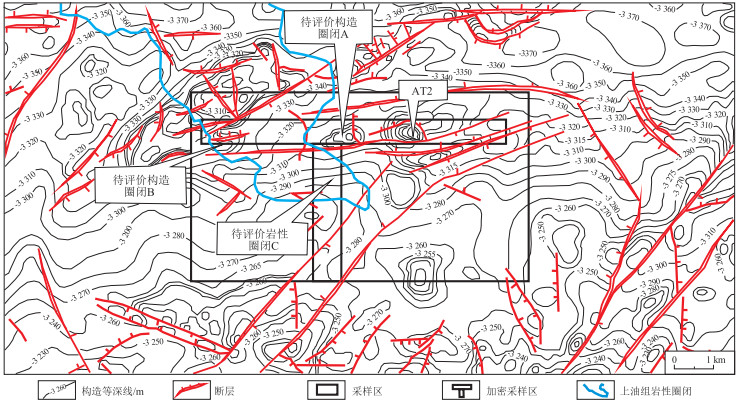The anomalies of high-precision geochemical exploration in well AT2 area of Tahe Oil Field, Tarim Basin and its geological significance for production
-
摘要: 为了评价塔里木盆地塔河油田AT2井区三叠系中、上油组多个圈闭的含油气性,采用基于烃类微渗漏的高精度化探技术在该井区进行了油气地球化学精查研究。选用的地球化学勘探指标均为活动态指标,包括游离烃、物理吸附烃以及顶空气。采用测网方式采集了近地表土壤样品,网度为0.25 km×0.25 km,在重点圈闭上方采用了0.1 km×0.1 km加密采样网格。以游离烃甲烷、物理吸附烃甲烷、顶空气甲烷为代表性指标,研究了AT2井区地球化学异常特征。在此基础上,确定了5个综合地球化学异常区(对应于5个圈闭)。通过化探—地质双因素评价方法,对上述5个化探异常区进行了排序,评价了圈闭的含油气性,为油田滚动开发提供了地球化学依据。Abstract: To evaluate the hydrocarbon potential of multiple traps in the middle and up oil groups of Triassic, an intensive oil and gas geochemical exploration has been carried out in the well AT2 area of the Tahe Oil Field of the Tarim Basin by the means of hydrocarbon microseepage-based high-precision geochemical exploration techniques.The geochemical indicators selected for this study were all active ones, including soil gas, physical adsorbed hydrocarbon gas and headspace gas.Near-surface soil samples were collected by means of a 0.25 km×0.25 km measuring grid, with a 0.1 km×0.1 km measuring grid over some key traps.Soil gas methane, physical adsorbed methane, and headspace methane were selected as the representative geochemical indicators, and their geochemical anomaly features over the well AT2 area were studied.Based on which, five integrated geochemical anomaly zones (consistent with five traps) were determined.The five integrated geochemical anomaly zones were ranked using a double-factor evaluation method combining geochemical and geological exploration evaluation parameters, and the hydrocarbon-bearing potential of these traps were evaluated, providing a geochemical basis for oil and gas rolling development of the well AT2 area.
-
图 2 塔河油田AT2井区地表游离烃甲烷浓度异常与三叠系中油组构造叠合图测区
范围为图 1中的矩形框区。
Figure 2. Superposition of near-surface free methane anomaly zones and middle oil group structures in well AT2 area, Tahe Oil Field
图 3 叠合法确定的塔河油田AT2井区地表综合地球化学异常
测区范围为图 1中的矩形框区。
Figure 3. Distribution of integrated surface geochemical anomalies determined by superposition method in well AT2 area, Tahe Oil Field
图 5 塔河油田AT2井区三叠系中油组区域构造、断裂、振幅、化探异常叠合图
测区范围见图 1。
Figure 5. Superposition of regional structures, fractures, seismic amplitude of Triassic middle oil group and surface geochemical anomaly zones in well AT2 area, Tahe Oil Field
图 6 塔河油田AT2井区西南三叠系上油组平均绝对振幅属性叠合顶面构造
测区范围见图 1。
Figure 6. Superposition of average absolute amplitude attribute and top structure of Triassic upper oil group in southwestern part of well AT2 area, Tahe Oil Field
表 1 塔河油田AT2井区地表地球化学综合异常化探参数评价概率及评价结果
Table 1. Geochemical evaluation probability and results of integrated surface geochemical anomaly zones in well AT2 area, Tahe Oil Field
化探参数 异常编号 1 2 3 4 5 总贡献率G/% 100 100 100 80 100 异常衬率C-/% 92.97 100 81.96 74.92 80.12 烃类热成因概率R/% 100 95.16 100 100 100 化探评价概率P/% 97.60 98.36 93.58 84.31 92.88 评价排序 Ⅱ Ⅰ Ⅲ Ⅴ Ⅳ 表 2 塔河油田AT2井区综合化探异常的地质评价概率及评价结果
Table 2. Geological evaluation probability and results of integrated surface geochemical anomaly zones in well AT2 area, Tahe Oil Field
地质评价参数 异常编号 1 2 3 4 5 圈闭落实S/% 75 75 75 75 75 断裂F/% 75 75 50 75 50 振幅r/% 75 50 50 75 25 地质评价概率Z/% 75 65.52 57.24 75 45.23 地质排序 Ⅰ Ⅱ Ⅲ Ⅰ Ⅳ -
[1] 漆立新, 郑和荣. 塔河油田碎屑岩目标评价及勘探技术研究[R]. 北京: 中国石化石油勘探开发研究院, 2019.QI Lixin, ZHENG Herong. Exploration targets evaluation and exploration technique research of the clastic rocks in Tahe oilfield[R]. Beijing: Sinopec Petroleum Exploration and Production Research Institute, 2019. [2] 刘崇禧, 程军, 赵克斌, 等. 油田开发中的化探精查技术[J]. 石油学报, 2001, 22(2): 62-65. https://www.cnki.com.cn/Article/CJFDTOTAL-SYXB200102012.htmLIU Chongxi, CHENG Jun, ZHAO Kebin, et al. The precise survey technique of geochemical exploration in the oil field's exploration and development[J]. Acta Petrolei Sinica, 2001, 22(2): 62-65. https://www.cnki.com.cn/Article/CJFDTOTAL-SYXB200102012.htm [3] 李武, 孙长青, 赵克斌, 等. 高精度油气地球化学勘探技术研究与应用[R]. 北京: 中国石化石油勘探开发研究院, 2014.LI Wu, SUN Changqing, ZHAO Kebin, et al. Research and application of the high-precision hydrocarbon geochemical exploration technique[R]. Beijing: SINOPEC Petroleum Exploration and Production Research Institute, 2014. [4] 马洪涛, 蔡玥, 付国民. 塔河油田AT1井区中三叠统中油组湖底扇沉积特征研究[J]. 岩性油气藏, 2010, 22(3): 53-58. https://www.cnki.com.cn/Article/CJFDTOTAL-YANX201003012.htmMA Hongtao, CAI Yue, FU Guomin. Sedimentary characteristics of sublacustrine fan of Middle Triassic Zhongyou Formation in AT1 area, Tahe Oilfield[J]. Lithologic Reservoirs, 2010, 22(3): 53-58. https://www.cnki.com.cn/Article/CJFDTOTAL-YANX201003012.htm [5] 张雷, 王英民, 杨婷, 等. 阿克亚苏地区三叠系中油组有利圈闭预测[J]. 石油地球物理勘探, 2009, 44(6): 739-746. https://www.cnki.com.cn/Article/CJFDTOTAL-SYDQ200906017.htmZHANG Lei, WANG Yingmin, YANG Ting, et al. Triassic middle oil-member favorite trap prediction in Akeyasu area[J]. Oil Geophysical Prospecting, 2009, 44(6): 739-746. https://www.cnki.com.cn/Article/CJFDTOTAL-SYDQ200906017.htm [6] 王国建, 汤玉平, 陈伟钧, 等. 一种物理吸附烃解吸密封罐及其化探应用效果[J]. 天然气地球科学, 2013, 24(4): 768-772. https://www.cnki.com.cn/Article/CJFDTOTAL-TDKX201304017.htmWANG Guojian, TANG Yuping, CHEN Weijun, et al. A seal jar for desorbing physical-adsorption hydrocarbons and its application effect[J]. Natural Gas Geoscience, 2013, 24(4): 768-772. https://www.cnki.com.cn/Article/CJFDTOTAL-TDKX201304017.htm [7] 索孝东, 李德春, 宋喜林. 用壤中游离烃现场分析解释技术直接寻找浅层油气藏[J]. 地质通报, 2009, 28(11): 1638-1642. https://www.cnki.com.cn/Article/CJFDTOTAL-ZQYD200911013.htmSUO Xiaodong, LI Dechun, SONG Xilin. Shallow oil and gas reservoir exploration in using on-site analysis and interpretation technology of free hydrocarbons in soil[J]. Geological Bulletin of China, 2009, 28(11): 1638-1642. https://www.cnki.com.cn/Article/CJFDTOTAL-ZQYD200911013.htm [8] 周亚龙, 孙忠军, 杨志斌, 等. 利用土壤游离烃技术判别油气藏性质及保存条件[J]. 现代地质, 2016, 30(6): 1370-1375. https://www.cnki.com.cn/Article/CJFDTOTAL-XDDZ201606020.htmZHOU Yalong, SUN Zhongjun, YANG Zhibin, et al. Application of soil free hydrocarbon to distinguish properties and preservation conditions of oil and gas[J]. Geoscience, 2016, 30(6): 1370-1375. https://www.cnki.com.cn/Article/CJFDTOTAL-XDDZ201606020.htm [9] 张宗元, 王国建. 土壤中游离烃技术的油气化探意义[J]. 天然气工业, 2004, 24(6): 30-32. https://www.cnki.com.cn/Article/CJFDTOTAL-TRQG200406009.htmZHANG Zongyuan, WANG Guojian. Petroleum geochemical exploration significance of soil free hydrocarbon technique[J]. Natural Gas Industry, 2004, 24(6): 30-32. https://www.cnki.com.cn/Article/CJFDTOTAL-TRQG200406009.htm [10] 李广之, 袁子艳, 胡斌. 顶空气技术在天然气化探中的应用[J]. 中国石油勘探, 2007, 12(6): 47-50. https://www.cnki.com.cn/Article/CJFDTOTAL-KTSY200706011.htmLI Guangzhi, YUAN Ziyan, HU Bin. Application of headspace gas technology to geochemical exploration[J]. China Petroleum Exploration, 2007, 12(6): 47-50. https://www.cnki.com.cn/Article/CJFDTOTAL-KTSY200706011.htm [11] CHENG Qiuming, AGTERBERG F P, BALLANTYNE S B. The separation of geochemical anomalies from background by fractal methods[J]. Journal of Geochemical Exploration, 1994, 51(2): 109-130. [12] 成秋明. 多维分形理论和地球化学元素分布规律[J]. 地球科学(中国地质大学学报), 2000, 25(3): 311-318. https://www.cnki.com.cn/Article/CJFDTOTAL-FGGL201701141.htmCHENG Qiuming. Multifractal theory and geochemical element distribution pattern[J]. Earth Science (Journal of China University of Geosciences), 2000, 25(3): 311-318. https://www.cnki.com.cn/Article/CJFDTOTAL-FGGL201701141.htm [13] 汤玉平, 魏巍, 李尚刚, 等. 油气化探异常评价的研究[J]. 物探与化探, 2002, 26(2): 131-134. https://www.cnki.com.cn/Article/CJFDTOTAL-WTYH200202010.htmTANG Yuping, WEI Wei, LI Shanggang, et al. A study of the appraisal of oil and gas geochemical anomalies[J]. Geophysical & Geochemical Exploration, 2002, 26(2): 131-134. https://www.cnki.com.cn/Article/CJFDTOTAL-WTYH200202010.htm [14] 於崇文. 数学地质的方法与应用: 地质与化探工作中的多元分析[M]. 北京: 冶金工业出版社, 1980.YU Chongwen. Methodolgy and application of mathematical geo-logy: multivariate analysis in geological and geochemical exploration practices[M]. Beijing: Metallurgical Industry Press, 1980. [15] JONES V T, MATTHEWS M D, RICHERS D M. Light hydrocarbons for petroleum and gas prospecting[M]//HALE M. Handbook of Exploration Geochemistry, vol. 7. Amsterdam: Elsevier, 2000: 133-212. [16] SECHMAN H, IZYDOR G, GUZY P, et al. Surface geochemical exploration for hydrocarbons in the area of prospective structures of the Lublin Trough (Eastern Poland)[J]. Marine and Petroleum Geology, 2015, 61: 22-38. -





 下载:
下载:







 苏公网安备32021102000780号
苏公网安备32021102000780号